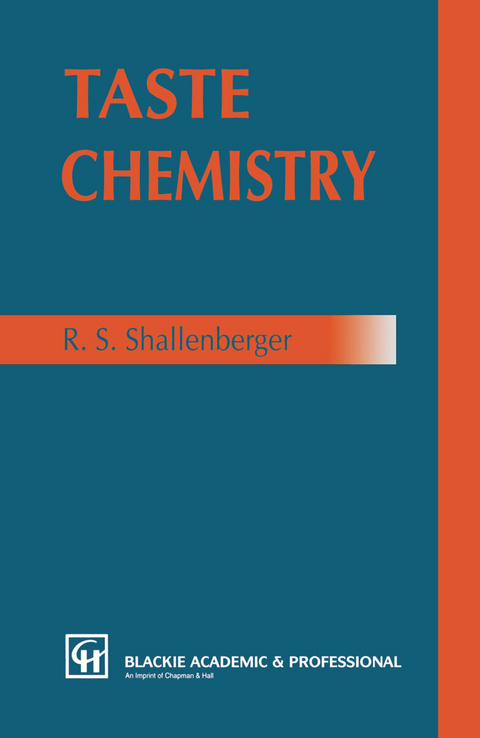
Taste Chemistry
Springer-Verlag New York Inc.
978-1-4613-6145-9 (ISBN)
Prologue.- 1. Chemical Nature, Psychology, and Physiology of Taste.- 1.1 General Nature of Taste.- 1.2 Taste Measurement.- 1.3 Psychophysical Principles.- 1.4 Transduction.- 1.5 Overview of the Taste of Chemicals.- 1.6 Chemical Interrelations Among the Four Tastes.- 2. Taste Themistry Principles.- 2.1 Chemical Equivalents.- 2.2 Water Solubility and Reactions in Water.- 2.3 pH, pK, and Total Acidity.- 2.4 Mass Action and Chemical Equilibria.- 2.5 Chemical Kinetics.- 2.6 Thermodynamics.- 2.7 Nature of Chemical Bonds and Chemical Reactions.- 2.8 Inductive and Resonance Effects.- 2.9 Isosteric Groups.- 2.10 Taste Structure-Activity Theory.- 2.11 Symmetry and Chirality.- 2.12 Recognition Chemistry.- 3. Water and Inorganic Compounds.- 3.1 Water.- 3.2 Alkali Metal and Halogen Salts.- 3.3 Lead and Beryllium Salts.- 3.4 Taste of Salts.- 3.5 Inorganic Acids.- 3.6 Sourness of Iorganic Acids.- 4. Polyhydroxy Alcohols, Cyclitols, and Carbonyl Compounds.- 4.1 Acyclic Polyhydroxy Alcohols.- 4.2 Cyclic Sugar Alcohols.- 4.3 Cyclitols.- 4.4 Hydroxy Carbonyl Compounds.- 5. Structure, Reactions and Properties of Sugars.- 5.1 Simple Sugars (Monosaccharides).- 5.2 Oligosaccharides.- 5.3 Reactions of Sugars.- 5.4 Properties of Sugars.- 6. Sweetness and other Taste Attributes of the Sugars.- 6.1 Intrinsic Sweetness of Sugars.- 6.2 Relative Sweetness of Sugars.- 6.3 Effect of Concentration on Relative Sweetness.- 6.4 Reactions Affecting Relative Sweetness.- 6.5 Relation Between Structure and Taste in the Sugar Series.- 6.6 Supplemental Food Attributes of Sugars.- 7. Amino Acids, Peptides and Proteins.- 7.1 Structure, Classification, and Properties of Amino Acids.- 7.2 Peptides and Proteins.- 7.3 Taste of Amino Acids.- 7.4 Taste of Peptides.- 7.5 Taste of Proteins.- 8. Organic Compounds.- 8.1 Sweet Organic Compounds.- 8.2 Bitter Organic Substances.- 8.3 Sour and Salty Organic Substances.- 9. The Common Saporous Units for Taste.- 9.1 The Common Acidophore.- 9.2 The Common Halophore.- 9.3 The Search for the Common Glycophore.- 9.4 The Picrophore.- 10. The Initial Chemistry of Taste.- 10.1 Initial Chemistry of Sourness.- 10.2 Initial Chemistry of Saltiness.- 10.3 Initial Chemistry of Sweetness.- 10.4 Special Qualitative Aspects of the Initial Chemistry of Sweetness.- 10.5 Initial Chemistry of Bitterness.- 10.6 Structure-Activity Relationships.- 10.7 Kinetic Theory.- 10.8 Mechanism (s) of Taste Inhibition.- 10.9 Recognition Chemistry Versus Binding Affinity.- 11. Symmetry, Chirality and Topology in Taste.- 11.1 Symmetry in Taste.- 11.2 Chirality in Taste.- 11.3 Chirality Plus Topology in Taste.- 11.4 Topology in Taste.- 11.5 Symmetry, Chirality and Topology in Retrospect.- 12. The Taste Receptor(s).- 12.1 The Taste Cell Membrane.- 12.2 Protein Nature of the Taste Receptor(S).- 12.3 Meaning of the Term ‘Different Receptors’.- 12.4 Single and/or Multiple Receptors for Each Basic Taste.- 12.5 Single and/or Multiple Receptors within Each Basic Taste.- 12.6 Generic Receptor Model for Taste.- Epilogue.- References.- Author Index.
| Zusatzinfo | XXIII, 613 p. |
|---|---|
| Verlagsort | New York, NY |
| Sprache | englisch |
| Maße | 140 x 216 mm |
| Themenwelt | Sachbuch/Ratgeber ► Essen / Trinken ► Grundkochbücher |
| Sachbuch/Ratgeber ► Natur / Technik ► Garten | |
| Naturwissenschaften ► Chemie ► Technische Chemie | |
| Technik ► Lebensmitteltechnologie | |
| ISBN-10 | 1-4613-6145-1 / 1461361451 |
| ISBN-13 | 978-1-4613-6145-9 / 9781461361459 |
| Zustand | Neuware |
| Haben Sie eine Frage zum Produkt? |
aus dem Bereich


